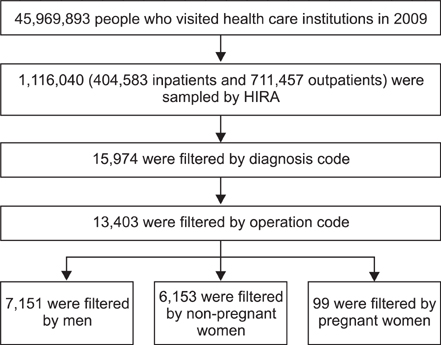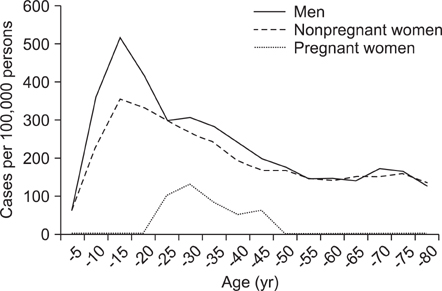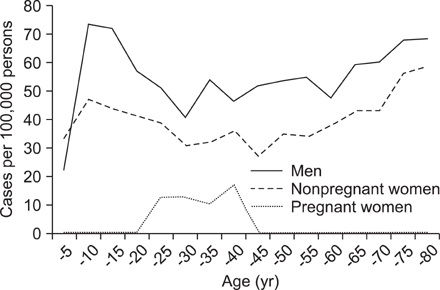J Korean Surg Soc.
2013 Aug;85(2):75-79. 10.4174/jkss.2013.85.2.75.
Association between pregnancy and acute appendicitis in South Korea: a population-based, cross-sectional study
- Affiliations
-
- 1Department of Obstetrics and Gynecology, Miz Medi Hospital, Seoul, Korea.
- 2Department of Obstetrics and Gynecology, Korea University College of Medicine, Seoul, Korea. shinjh@korea.ac.kr
- KMID: 2212520
- DOI: http://doi.org/10.4174/jkss.2013.85.2.75
Abstract
- PURPOSE
To estimate the prevalence of acute appendicitis and the relationship between pregnancy and acute appendicitis among South Korean women in 2009.
METHODS
This was a cross-sectional study over 1 year period using a national registry data. We analyzed a national patient sample (n = 1,116,040) from a database complied by the South Korean National Health Insurance in 2009.
RESULTS
We identified 15,974 cases of acute appendicitis from 2009. The prevalence rate of acute appendicitis was 228 +/- 2 per 100,000 persons. The prevalence in men was higher than in women. The peak prevalence of the disease in both genders occurred in patients aged 10 to 14 years. After that, prevalence declined with age. The prevalence of acute appendicitis in women aged 20 to 39 years was negatively associated with age and pregnancy (P < 0.001) but was not associated with socioeconomic status. The prevalence of perforated appendicitis cases by age is represented by a U-shaped curve. The prevalence was highest in people less than five years of age and in people older than 60 years.
CONCLUSION
We found that the prevalence of acute appendicitis decreased with increasing age after early teens, and that the prevalence of acute appendicitis in pregnant women was lower than in nonpregnant women.
Keyword
MeSH Terms
Figure
Cited by 1 articles
-
Clinical Significance of National Patients Sample Analysis: Factors Affecting Mortality and Length of Stay of Organophosphate and Carbamate Poisoned Patients
Kyoung-Ho Kim, In Ho Kwon, Jun Yeob Lee, Woon Hyung Yeo, Ha Young Park, Kyung Hye Park, Junho Cho, Hyunjong Kim, Gun Bea Kim, Deuk Hyun Park, Yoo Sang Yoon, Yang Weon Kim
Healthc Inform Res. 2013;19(4):278-285. doi: 10.4258/hir.2013.19.4.278.
Reference
-
1. Addiss DG, Shaffer N, Fowler BS, Tauxe RV. The epidemiology of appendicitis and appendectomy in the United States. Am J Epidemiol. 1990. 132:910–925.2. Birnbaum BA, Wilson SR. Appendicitis at the millennium. Radiology. 2000. 215:337–348.3. Nitecki S, Karmeli R, Sarr MG. Appendiceal calculi and fecaliths as indications for appendectomy. Surg Gynecol Obstet. 1990. 171:185–188.4. Jones BA, Demetriades D, Segal I, Burkitt DP. The prevalence of appendiceal fecaliths in patients with and without appendicitis: a comparative study from Canada and South Africa. Ann Surg. 1985. 202:80–82.5. Pastore PA, Loomis DM, Sauret J. Appendicitis in pregnancy. J Am Board Fam Med. 2006. 19:621–626.6. Kim RY. Introduction to HIRA-NPS. Health Insur Rev Assess Serv. 2012. 6:37–47.7. Keeling SO, Oswald AE. Pregnancy and rheumatic disease: "by the book" or "by the doc". Clin Rheumatol. 2009. 28:1–9.8. Wegmann TG, Lin H, Guilbert L, Mosmann TR. Bidirectional cytokine interactions in the maternal-fetal relationship: is successful pregnancy a TH2 phenomenon? Immunol Today. 1993. 14:353–356.9. Cutolo M, Capellino S, Sulli A, Serioli B, Secchi ME, Villaggio B, et al. Estrogens and autoimmune diseases. Ann N Y Acad Sci. 2006. 1089:538–547.10. Andersson RE, Lambe M. Incidence of appendicitis during pregnancy. Int J Epidemiol. 2001. 30:1281–1285.11. Somerset DA, Zheng Y, Kilby MD, Sansom DM, Drayson MT. Normal human pregnancy is associated with an elevation in the immune suppressive CD25+ CD4+ regulatory T-cell subset. Immunology. 2004. 112:38–43.12. Anderson JE, Bickler SW, Chang DC, Talamini MA. Examining a common disease with unknown etiology: trends in epidemiology and surgical management of appendicitis in California, 1995-2009. World J Surg. 2012. 36:2787–2794.13. Buckius MT, McGrath B, Monk J, Grim R, Bell T, Ahuja V. Changing epidemiology of acute appendicitis in the United States: study period 1993-2008. J Surg Res. 2012. 175:185–190.14. Ohmann C, Franke C, Kraemer M, Yang Q. Status report on epidemiology of acute appendicitis. Chirurg. 2002. 73:769–776.15. Primatesta P, Goldacre MJ. Appendicectomy for acute appendicitis and for other conditions: an epidemiological study. Int J Epidemiol. 1994. 23:155–160.16. Petro M, Minocha A. Asymptomatic early acute appendicitis initiated and diagnosed during colonoscopy: a case report. World J Gastroenterol. 2005. 11:5398–5400.17. Lunca S, Bouras G, Romedea NS. Acute appendicitis in the elderly patient: diagnostic problems, prognostic factors and outcomes. Rom J Gastroenterol. 2004. 13:299–303.18. Rothrock SG, Skeoch G, Rush JJ, Johnson NE. Clinical features of misdiagnosed appendicitis in children. Ann Emerg Med. 1991. 20:45–50.19. Andersen B, Nielsen TF. Appendicitis in pregnancy: diagnosis, management and complications. Acta Obstet Gynecol Scand. 1999. 78:758–762.20. Mazze RI, Kallen B. Appendectomy during pregnancy: a Swedish registry study of 778 cases. Obstet Gynecol. 1991. 77:835–840.21. Mourad J, Elliott JP, Erickson L, Lisboa L. Appendicitis in pregnancy: new information that contradicts long-held clinical beliefs. Am J Obstet Gynecol. 2000. 182:1027–1029.
- Full Text Links
- Actions
-
Cited
- CITED
-
- Close
- Share
- Similar articles
-
- Acute Appendicitis during Pregnancy
- Spontaneous heterotopic pregnancy after missed abortion and acute appendicitis treated by laparoscopy
- Acute Appendicitis
- Acute Appendicitis in Pregnant Patients and Non-Pregnant Patients: Recent Clinical Experience of the Tertiary Hospital
- A clinical study of acute appendicitis in pregnancy





